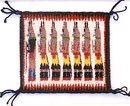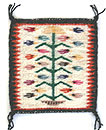
![]() Back to Native American Crafts Information Menu
Back to Native American Crafts Information Menu
Origins
Among the tribes of the American Southwest, weaving began with the Pueblo peoples who used upright looms to weave natural cotton into fabric. Only after the Spanish came bringing horses, cattle and sheep, did weaving become important among the Navajos (Dine').
The Pueblo Revolt of 1680 led to the westward flight of some Pueblo members into Navajo lands. It is believed that during this time the Navajo learned weaving from the Pueblo men. For some reason the Navajo women, not the men, took up weaving, and were so successful with it that in two generations the Spanish were remarking on the superiority of Navajo textiles.
During the early period of Navajo weaving many of the products were made into clothing for the Navajos themselves, but a large amount was sold or traded to the Spanish as well as to other Indian tribes. By the mid-1800s, Navajo trade blankets were prized by the chiefs of many Plains tribes, and weaving was done mainly for export rather than for domestic use.
The arrival of the reservation traders in the period between 1870-1880 changed the appearance of Navajo weaving forever, and resulted in textiles being made solely for income. The traders not only encouraged Navajo weavers to produce higher quality weaving, but they commissioned distinctive weaving patterns that became common among local weavers, and today are associated with different areas of the reservation, such as the well-known Two Gray Hills pattern.
Because fewer and fewer Navajo women are continuing the art of weaving, today Navajo rugs are selling for much higher prices than in the past.
If you want to invest in a Navajo rug, needless to say, you should go to a reputable dealer, unless you are fortunate enough to be traveling through New Mexico when the Crownpoint Rug Auctions are held, or can attend one of the Native American craft fairs whose sponsors require their vendors to be enrolled members of their tribe and to guarantee the authenticity of their work.
The Navajo Loom
The traditional upright Navajo loom has no mechanical parts. The support poles may be either wood or (more commonly today) steel pipe. The weaver sits on the floor and works from the bottom up. Once the rug is about two feet high, it is wrapped under the bottom pole and up the back.
A traditional Navajo rug has no knots. When the weaver wants to add a different color to her design, she takes a separate ball of yarn and weaves and pounds the yarn into the warp with a wooden weaving fork or comb. If the design is very complex, the weaver may have 15 or so little balls of yarn hanging from her work.
The warp determines the size of the rug. Once the weaver get to the top, the weaving fork will no longer fit in to pound down the wool, so she does the final inch with a needle threaded with yarn, and pounds it with a dinner fork. The remaining space up to the edge is finished using needle and yarn. This is why some warp fibers show through about an inch down from the edges, even on very high quality rugs.
If the pattern is not a stripe, traditional rugs may have a spirit line--a single thread of yarn connecting the center of the rug with an edge--allowing the weaver to let her spirit out of that rug so that she can go on to create other rugs. Weaving a large rug may take 300 hours of work.
A really traditional weaver will card and spin her own yarn, or use only hand spun yarn. Spinning a thin, even thread with the wooden hand spindle is an art in itself.
Navajo Rug Patterns
Shiprock-Red Rock Rug. Also called Yei rugs because they have figures of Yeis, taken from traditional sand paintings. Yeis are part of Navajo religion, but the rugs themselves have no religious significance. Yeis are always woven face-on.
Yeibechai Rug. These rugs show a line of Yeibechai dancers from the healing ceremony and come from the same area as Yei rugs. Yeibechai dancers are usually woven in profile.
 Example of Yeibechai rug
Example of Yeibechai rug
Teec Nos Pos Rug. Teec Nos Pos rugs have a strong border and a central geometric pattern that has been outlined. They may also have a serrated zigzag pattern and contain many colors not common to Navajo rugs. Therefore, most Teec Nos Pos rugs use commercially spun and dyed yarns.
Red Mesa Rug. Red Mesa rugs are similar to Teec Nos Pos rugs in design, but are not as colorful. They usually contain gray, black, white and red, with a few bars of other colors.
Two Gray Hills Rug. Earth tones and natural wool colors of gray, white, black and brown predominate in Two Gray Hills rugs; they usually have a central diamond pattern with four equal triangle shapes at the corners.
Crystal Rug. Crystal rugs have simple woven strips, some containing geometric patterns; colors are usually vegetal dyes in tones of brown, yellow, tan, orange and black. They may also have wavy lines, which are created by alternating threads of contrasting colors in the stripes.
Gallup Throw. Gallup area weaving traditionally used a cotton twine warp left loose at the ends and tied to make a fringe. The throws, smaller than a normal Navajo rug, may contain patterns from all parts of the reservations. The throws were originally developed as a craft to sell to tourists on the railroad line running through Gallup.
Chinle Rug. Squash blossom patterns alternating with wavy lines and solid-colored strips are characteristic of Chinle rugs. These rugs usually are woven with vegetal-dyed yarn.
 Example of Chinle pattern rug.
Example of Chinle pattern rug.
Wide Ruins Rug. These rugs are composed of horizontal strips, some with geometric patterns, and usually use vegetal dyes.
Burntwater Rug. Burntwater rugs combine a Two Gray Hills style pattern with the colors used in a Wide Ruins rug.
Ganado Rug. Gold geometric patterns woven in black, gray, white and red is typical of Ganado rugs. They may have a black border, patterns of crosses and diamonds and red backgrounds.
Western Reservation Rug. The storm pattern showing four stepped lines representing lightning radiating from a central rectangle is characteristic of western reservation rugs from areas such as Tuba City. A block in each corner of the rug represents the four sacred mountains.
Other Rugs. During the 20th Century creative Navajo weavers invented a number of new styles of rugs. These include double wrapped rugs, in which the weaver creates a raised outline on the rug by double wrapped threads on the edge of the design, double woven rugs which have a different pattern on each side, tree of life rugs showing a corn plant with a variety of reservation birds perching on the leaves, and picture rugs, usually showing typical reservation scenes with hogans, trucks, people, mesas and livestock.
 Example of Navajo Tree of Life rug
Example of Navajo Tree of Life rug
What to Look for in a Navajo Rug
First of all--pick a rug you like, one that says something to you, but be aware that its actual value depends on many things including quality of yarn, dyes, craftsmanship and, originality.
Hand-spun versus machine-spun. Today many weavers use machine spun wool yarn because as a general rule, machine-spun yarn is more even and finer (thinner) while hand-spun yarn is coarser or thicker, and really fine hand-spun yarn is expensive and hard to come by.
Aniline versus vegetal dyes. Early Navajo rugs used only three vegetal dyes. The popularity of natural dyes today is due to the work of a talented Navajo weaving teacher who began to experiment with vegetal dyes from reservation plants during the 1930s. She developed 84 different colors. The only color that has no vegetal equivalent is bright red; any red yarn in a Navajo rug is an aniline dye.
Vetegal dyes give beautiful pastel colors. The precise shade depends on what part of the plant was used, whether the plant was used fresh or dry, and how long the yarn stayed in the dye bath. Vegetal dying is a separate art.
Aniline dyes give brighter colors--red, bright greens, and snow white, for example. Some rugs use exclusively vegetal dyes and natural colored wools; others combine natural wool with aniline and/or vegetal dyes.
This information is provided to help you in selecting and evaluating Native American jewelry and crafts.
We are happy to answer questions by email.
Please note that Coyote's Game does not buy or sell used or vintage rugs, nor do we appraise rugs. The only Navajo rugs we sell are mini rugs.
Email us at
© 1999-2025 Coyote's Game. Reproduction without permission is prohibited.
